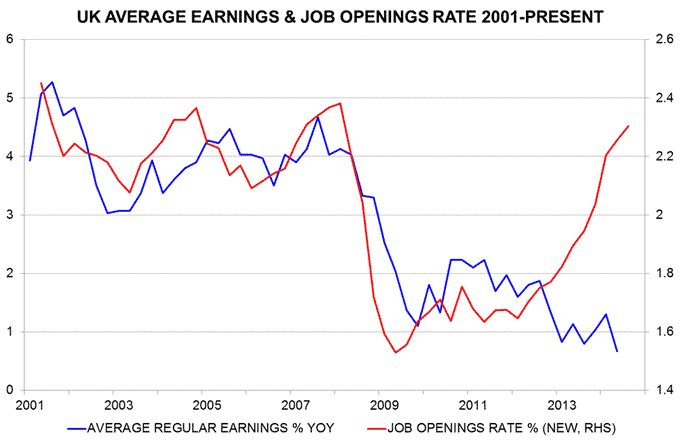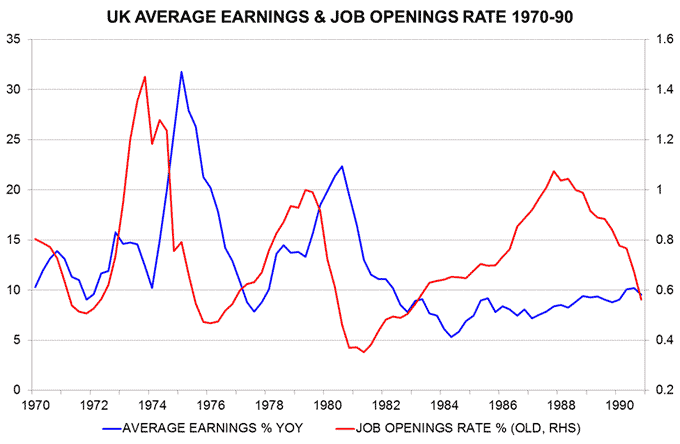Entries from September 21, 2014 - September 27, 2014
Eurozone money numbers better, economic outlook improving
Eurozone money measures rose solidly again in August, suggesting improving economic prospects and initial success for the ECB’s June easing measures.
Broad money M3 rose by 1.0%, or 6.1% annualised, in July and August combined, while narrow money M1 surged by 1.9%, or 12.2% annualised.
Six-month growth of real (i.e. inflation-adjusted) narrow money M1 has risen from 1.6% (not annualised) in April to 2.6% in August, a solid pace by historical standards. Real M3 expansion has recovered from 0.1% to 1.2% over the same period, the latter reading being the highest since October 2012, ahead of an economic recovery in 2013 – see first chart.
The July-August M3 increase partly reflected a resumption of bank buying of government securities*, following the ECB’s June announcement of cheap fixed-rate funding via the TLTROs (targeted longer-term refinancing operations). M1 is driven by household and corporate demand for transactions money – the recent surge suggests rising spending intentions.
The ECB publishes a country breakdown of overnight deposits, comprising about 80% of Eurozone M1. The six-month rate of change of real deposits has strengthened in Spain and Italy, remained broadly stable at a solid level in France and Germany and weakened further in the Netherlands – second chart. These numbers can be volatile from month to month but narrow money growth appears to be on a higher trend across the periphery than in the core – third chart.
US six-month real narrow money growth was much higher than in the Eurozone at the start of 2014, signalling US economic and equity market outperformance. Current growth rates are similar, mainly reflecting a recent US slowdown.
*Bank purchases were €43 billion, seasonally adjusted, in July-August versus an M3 increase of €98 billion.



UK job openings suggesting early earnings pick-up
The August Inflation Report introduced a new reason for continuing to delay a rise in interest rates – the labour supply, it claimed, has been expanding faster than expected, explaining the recent puzzling combination of strong employment growth with weak wages, while implying still-significant economic slack.
This “theory” is viewed here as implausible, for two reasons. First, it is at odds with official labour force statistics, showing a rise of 0.9% in the three months to July from a year before, equal to the average annual growth rate since 2005. (The Bank's claim may have been influenced by a rise in annual growth to 1.7% in the three months to April, the most recent number when the Report was prepared; this partly reflected a favourable base effect and has since reversed.)
Secondly, a labour supply surge should have slowed the rate of decline of unemployment while helping employers to fill vacancies. The jobless rate, however, has fallen considerably faster over the last six months than during the previous half-year (1.0 versus 0.5 percentage points). The job openings rate (i.e. vacancies expressed as a percentage of filled and unfilled jobs), meanwhile, has continued to rise rapidly and is almost back to its pre-recession peak.
Weak earnings growth probably reflects two factors – problems with the official data and the normal lag between labour market quantities and wages. Surveys paint a stronger picture – the September Markit household finance index, for example, reports the joint-fastest rise in income from employment in its 68-month history. Interestingly, the latest MPC minutes refer to Bank research into the official data suggesting that workforce composition effects “have been pulling down on average wage growth, perhaps significantly”.
The first chart below shows average regular earnings growth and the job openings rate since 2001, when the current vacancies series begins. The relationship over this period suggests that earnings growth should already have risen substantially.
A longer look back, however, indicates that current developments are not so unusual. The second chart shows earnings growth and an earlier version of the job openings rate over 1970-90*. There were three large rises in the openings rate over this period. Earnings growth followed with a lag of between six and 12 quarters.
Returning to the recent past, the openings rate bottomed in 2009 but embarked on a sustained rise only in the second quarter of 2012. Based on the average nine-quarter lag following the three increases over 1970-90, this suggests an upswing in earnings growth starting in the third quarter of 2014.
The lack of movement of wage growth to date, therefore, is consistent with history but a significant pick-up is now likely. With the labour market continuing to tighten, moreover, the coming increase should be sustained into 2016, at least.
*Based on vacancies at Jobcentres.

Farewell UK Bank Return - BoE now least open of major CBs
The Bank of England will this week cease publication of the Bank Return – a weekly summary statement of its assets and liabilities. The Bank claims that it needs to hide its balance sheet in order to fulfil its responsibility for maintaining financial stability. No other major central bank shares this view. It will no longer be possible to monitor some of the Bank’s activities in a timely fashion.
The Bank Return is 170 years old. The requirement to publish a weekly statement was introduced by the 1844 Bank Charter Act in order to strengthen confidence in the currency by demonstrating that the note issue was backed by gold and other assets.
The Bank lobbied for this requirement to be removed following the 2008 Northern Rock debacle, when analysts used the Bank Return to estimate emergency lending to the failing institution. This request was implemented in the Banking Act 2009 but the Bank did not immediately cease publication, probably because it would have attracted criticism for doing so at a time when the banking system was still receiving large-scale official support.
To create cover for the desired course of action, the Bank asked former insider Ian Plenderleith to consider the future of the Bank Return as part of a review of its emergency liquidity assistance operations during the crisis. Reporting in 2012, Plenderleith duly recommended that the Bank should cease publication “in order to improve its ability to provide covert liquidity assistance in future”.
Ignoring the undesirable loss of transparency and accountability, why should liquidity assistance be more effective if covert? Markets usually know when an institution is receiving central bank support; withholding information on the scale of support creates unnecessary uncertainty. Confirmation of large-scale assistance, indeed, may have a stabilising effect by demonstrating a central bank’s commitment to fulfil its lender of last resort responsibilities.
No other major central bank shares the Bank’s view that transparency must be sacrificed in order to ensure financial stability. The central banks of the US, Eurozone, Japan, Canada and Australia, among others, continue to publish weekly* balance sheet statements, in most cases with more detail than the Bank Return. Other central banks provide monthly statements.
The Bank will replace the Bank Return with a new weekly report giving information on selected balance sheet items but no aggregate assets / liabilities figure. The full balance sheet will be published quarterly with a five quarter lag and annually with a three to four month lag in the Bank’s Annual Report. The Bank is under no obligation to maintain these arrangements; it could choose to lengthen the lags even further or suspend publication entirely.
The original aim of the Bank Return – to demonstrate responsible management of the Bank’s balance sheet – remains important today. Monetary stability rests on confidence in the Bank’s ability to meet its obligations without printing money unbacked by assets. Ceasing publication may encourage conspiracy theories that the Bank wishes to engage in risky lending or interfere in markets, or even that the Treasury plans to cancel the Bank’s gilt holdings. Reduced disclosure, in other words, may result in more, not less, destabilising speculation.
*Japan publishes every 10 days.

